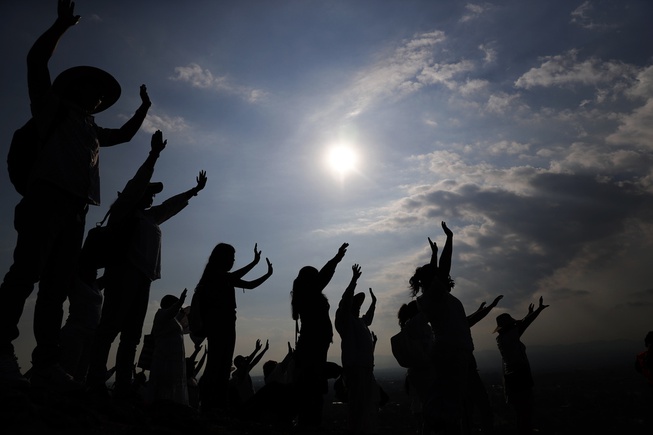
Marco Ugarte / AP
Visitors hold their hands out to receive the sun’s energy as they celebrate the Spring equinox atop the Pyramid of the Sun in Teotihuacan, Mexico, Thursday, March 21, 2019.
Monday, March 18, 2024 | 1:56 p.m.
Spring is almost here — officially, at least.
The vernal equinox arrives on Tuesday, marking the start of the spring season for the Northern Hemisphere.
But what does that actually mean? Here's what to know about how we split up the year using the Earth's orbit.
What is the equinox?
As the Earth travels around the sun, it does so at an angle.
For most of the year, the Earth’s axis is tilted either toward or away from the sun. That means the sun’s warmth and light fall unequally on the northern and southern halves of the planet.
During the equinox, the Earth’s axis and its orbit line up so that both hemispheres get an equal amount of sunlight.
The word equinox comes from two Latin words meaning equal and night. That’s because on the equinox, day and night last almost the same amount of time — though one may get a few extra minutes, depending on where you are on the planet.
The Northern Hemisphere’s spring — or vernal — equinox can land between March 19 and 21, depending on the year. Its fall – or autumnal — equinox can land between Sept. 21 and 24.
What is the solstice?
The solstices mark the times during the year when the Earth is at its most extreme tilt toward or away from the sun. This means the hemispheres are getting very different amounts of sunlight — and days and nights are at their most unequal.
During the Northern Hemisphere’s summer solstice, the upper half of the earth is tilted in toward the sun, creating the longest day and shortest night of the year. This solstice falls between June 20 and 22.
Meanwhile, at the winter solstice, the Northern Hemisphere is leaning away from the sun — leading to the shortest day and longest night of the year. The winter solstice falls between December 20 and 23.
What's the difference between meteorological and astronomical seasons?
These are just two different ways to carve up the year.
Meteorological seasons are defined by the weather. They break down the year into three-month seasons based on annual temperature cycles. By that calendar, spring starts on March 1, summer on June 1, fall on Sept. 1 and winter on Dec. 1.
Astronomical seasons depend on how the Earth moves around the sun.
Equinoxes mark the start of spring and autumn. Solstices kick off summer and winter.
___
The Associated Press Health and Science Department receives support from the Howard Hughes Medical Institute’s Science and Educational Media Group. The AP is solely responsible for all content.
